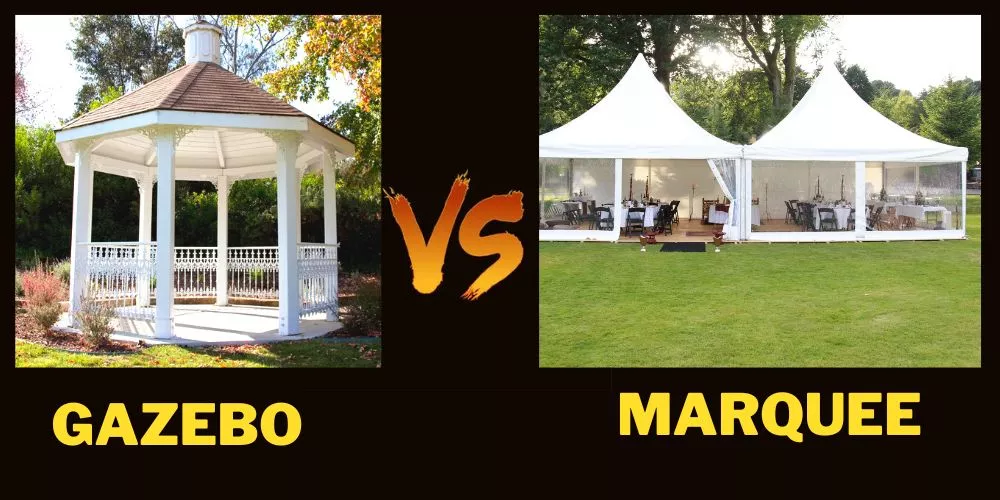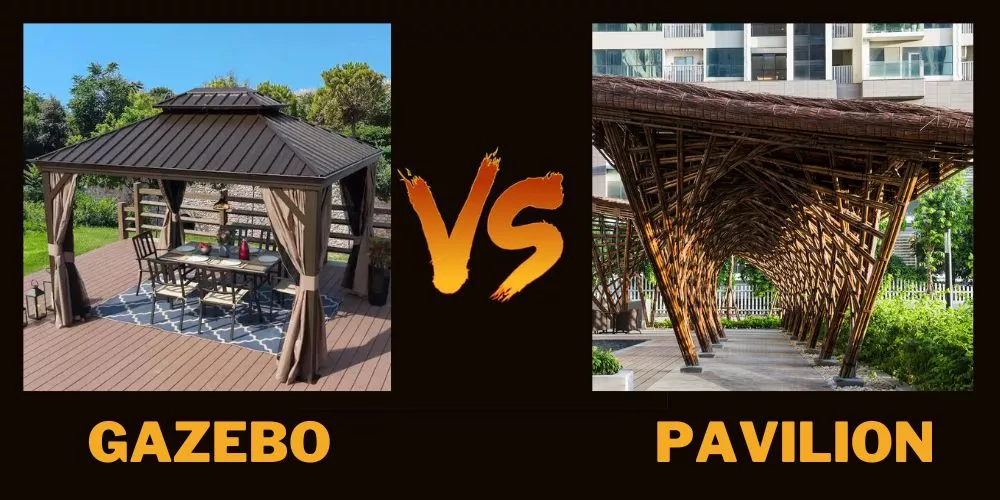Purchasing a gazebo adds that next level to your outdoor area. Whether it’s in the backyard as a solid structure, some beach shade, or even that extra space for a camp kitchen, they just make sense.
One of the biggest questions when going out and researching them, though, is if hardtops or soft tops are more beneficial and why. In this article, I will address the hardtop vs soft top gazebo debate in a detailed manner, so that anyone can take an informed decision.
On the one hand, hard tops are generally for more permanent structures. At the same time, soft top gazebos are usually built for transport and portability.
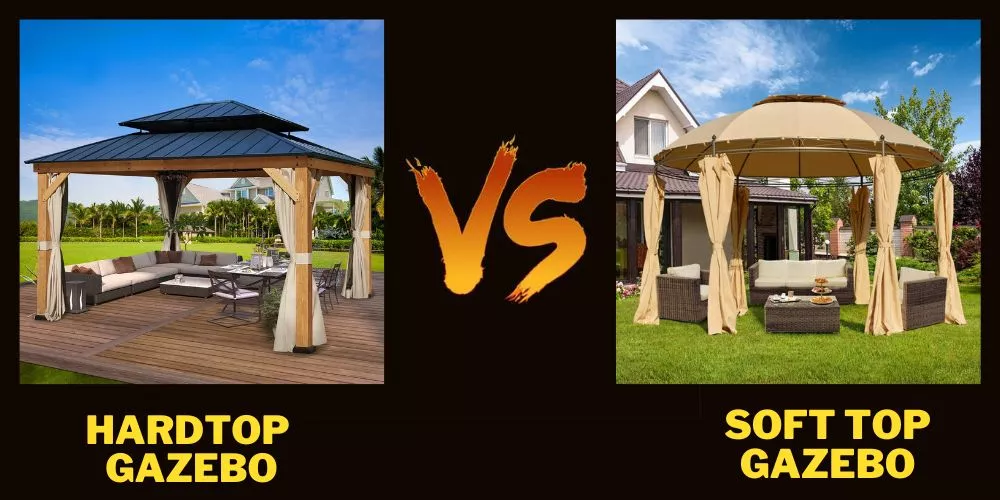
However, this is not always the case. In this article, we’ll go into all the nitty gritty surrounding the two options to help you come out on the other side with a clear winner for your use case in mind.
Sounds good? Let’s go!
What is a Hardtop Gazebo?
Hardtop gazebos can come in many shapes, sizes, and forms. Furthermore, they have roofs made from stronger materials such as metal or galvanized steel. These hardtop gazebo structures are built to protect something or someone.
They can also be used for many different purposes. These include an undercover hot tub or barbeque area, a garden pavilion, and an all-weather shelter for outdoor furniture. They are generally built on site so that they will stay erect for an extended or unknown period.
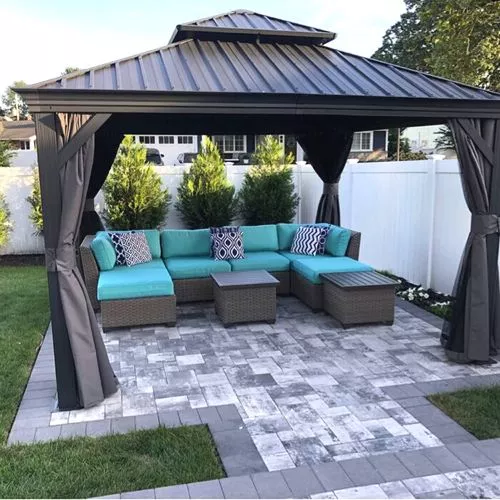
What is a Soft Top Gazebo?
Much like hardtops, soft top gazebos also come in various forms depending on their intended usage. These types of gazebos are generally designed for their versatility. They are also made to withstand the rigors of transportation and maneuverability.
So they are durable but not as much as hard tops. Some common uses of soft top gazebos include pop-up beach variants, shop awnings, wedding shelters, and garden pergolas. They are generally made from materials that can handle constantly opened, closed, dragged, pulled, and other actions surrounding setup and pack up. These materials used to manufacture soft top gazebos are usually fabrics and light duty steels such as aluminum.
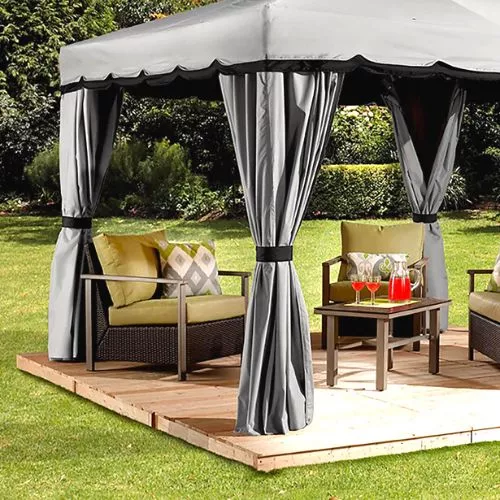
Which is better: a hard top or soft top gazebo?
The best way to decide which of the two gazebo types is better is by simply looking at the usage. A hard top would be sturdy and reliable if you want to build more of a semi-permanent to a permanent structure.
The materials are much stronger and designed to become almost a popuppop-up but well anchored shelter. Using a hard top gazebo, you could build a pool shade or rain shelter. A carport can be created by attaching it to your house using a gazebo.
On the other hand, a soft top would be a much better option if you were to participate in outdoor activities regularly, such as camping, days at the beach, or even sports. The best part about soft tops is that the ones designed for portability come in some kind of carry case. This makes it quite easy to lug around, and in most cases, they only require one set of hands. Soft top gazebos are great for fast erection and dismantling.
These are just a few minor examples of the different types of both hardtop and soft top gazebos. People are getting increasingly creative with their gazebos these days, making them a really good investment if you use them often.
Hardtop vs Soft Top Gazebo: Differences and Similarities
Regarding gazebos, hard and soft tops were designed and manufactured for their own specific purposes. They just aren’t meant to be used in a way that can affect their longevity. Hard top gazebos are built for stability and protection. They can stand tall against the elements as long as they are built with decent materials.
In contrast, soft tops are built for their versatility and maneuverability. Braving strong winds, rains and snow just aren’t their strong suit. However, aside from each design’s differences, some similarities between the two are worth mentioning. Let’s first look at the differences between hardtops and soft top gazebos.
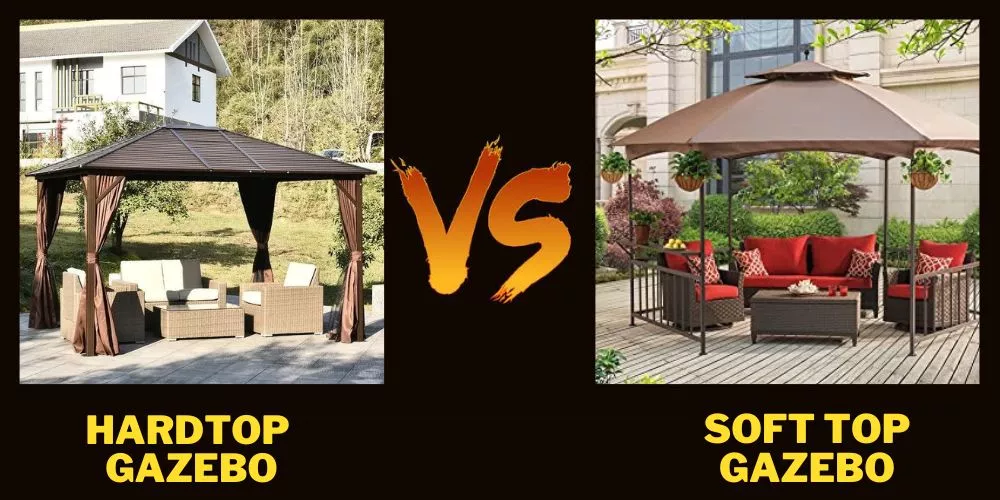
Then we can round off with some similarities. Hopefully, these well-researched points help paint a better picture when deciding which type of variant is right for you.
Differences
1. Strength
The major difference between the two types of gazebos is their overall strength. With strength comes a range of other qualities as well. The hard tops are physically constructed using nails or screws, beams, trusses, and cladding.
Therefore they are well stitched together and can hold their own for long periods. At the same time, the soft tops have fabrics or canvas resting on some light frame struts, held together with strategically placed eyelets and buttons. This makes them much weaker.
2. Customization
As mentioned, hard tops are usually pieced together to be customized to suit the user. You can simply leave off something you don’t like and add a better quality piece or a different color. At the same time, soft tops are usually designed to function as they are bought. You set them up for a specific purpose, then remove them again. There isn’t too much that can be done as far as alterations are concerned.
3. Versatility
The points go to soft tops on this one. They are usually created so the user can set them up, dismantle them and store them again. This makes them far superior in camping, sports days, and beach setups. The hard tops cannot be removed with as little effort, nor would you wish to remove them as often as you would a soft top.
4. Price
Ultimately, you pay for what you get. Of course, some really good quality soft top gazebos warrant their price tag. But hard tops will almost always be more expensive. This is due to their heavy duty construction, which requires more expensive materials. Hence a higher price.
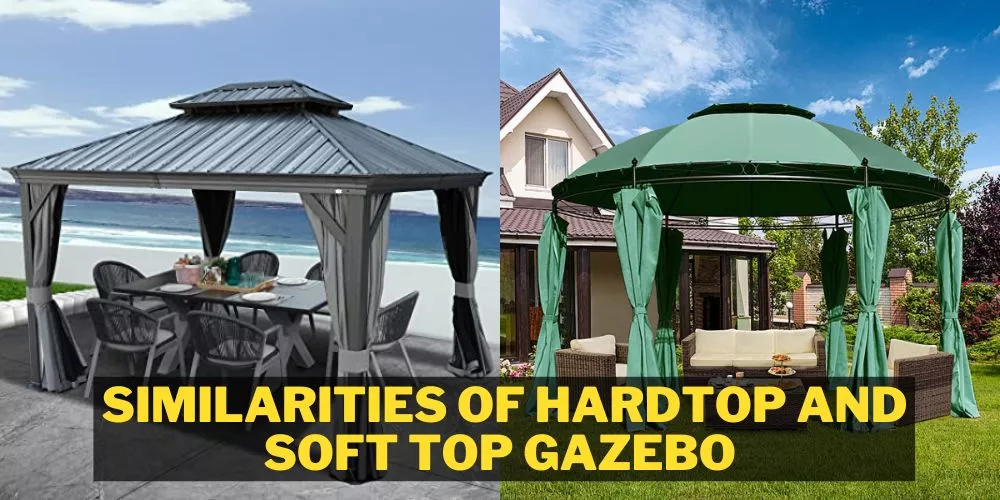
Similarities
There aren’t as many similarities as there are differences. In saying that, they can both put a roof over your head. This helps to offer respite from the harsh sun as well as light rains. Additionally, both variants look great, regardless of their setup styles. Lastly, they just serve the specific purpose that they were designed for.
What is the best gazebo roof?
Quality should always be the deciding factor when we look at the roof of a gazebo. Nothing is worse than purchasing a product mainly designed to protect from the weather, but the greatest advantage, a.k.a. ‘the roof,’ is constantly looking like it may tear or collapse at any time. Furthermore, poorer quality materials may be more susceptible to mold.
Many different materials can be used to construct a gazebo roof. For example, a soft top gazebo roof can be made using fabrics or canvas. Hard top gazebos are usually made using fortified steels and aluminum to a specific weight ratio. The best gazebo roof will be the one that suits the needs of the user. Let’s have a look at some of the most common materials.
Hard Top Materials
- Asphalt shingles: These are pretty common. They can easily match your home’s colors if you construct a carport or other semi-detached structure. It’s also extremely easy to install and reasonably inexpensive.
- Steel: Steel is a good strong option, but it needs to be powder coated to avoid rusting. It’s generally more expensive as it’s heavier. The upside is that it’s extremely stable and can be easily customized. Ideal for all weather challenges.
- Aluminum: The lighter, little brother of steel is much cheaper and easier to work with. It can be cut and customized by a much simpler tool. Another great choice for the elements.
- Polycarbonate Sheets: Twin or multi walled sheets are durable and strong against any weather impact. They are also economical.
Soft Top Materials
- Polyester: Probably the most common, which makes it inexpensive. This material is easy to maintain. It’s more suited for sun and light rain but won’t fare too well in heavy storms or snow.
- Polyethylene: This material is also common. It’s tear resistant and fares pretty well against most lighter weather issues. It’s lightweight and slightly stretchy, which helps avoid tearing.
- Sunbrella: This material is known for its shading characteristics. It’s machine washable and generally easy to maintain. Not suited for heavy storms or snow. This type of fabric can last 3-15 years if treated well.
How long Do hardtop gazebos last?
Hard top gazebos are designed to last. They are usually built to withstand wind, rain, sun, and snow. Depending on the quality of the material and use case, it’s not uncommon for a structure of this nature to last 10 years at a minimum. Some hard top gazebos are even built in such a way that they are the same quality as a house.
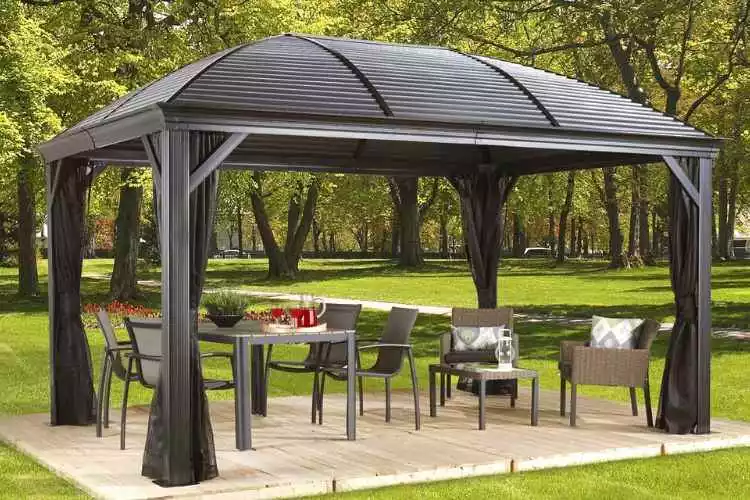
They may even stand upright for as long as 25+ years. You’re generally paying good money for sturdy and reliable materials. That’s not to say there aren’t some cheaply designed and poorer quality gazebos out there. As the saying goes, ‘you pay for what you get. Most manufacturers will have a certain time frame guarantee on their product. Even then, it’s important to maintain a hard top gazebo according to the manufacturer’s instructions. Otherwise, the lifetime may shorten unexpectedly.
How long do soft top gazebos last?
Soft top gazebos are made from materials such as fabrics and lighter duty steels like aluminum. Therefore, their construction is not designed to last as long as the hard tops. Furthermore, these structures are constantly stored, moved, erected, dismantled, stretched, transported, etc. Therefore, the length of time they last is severely hampered by excessive movements.
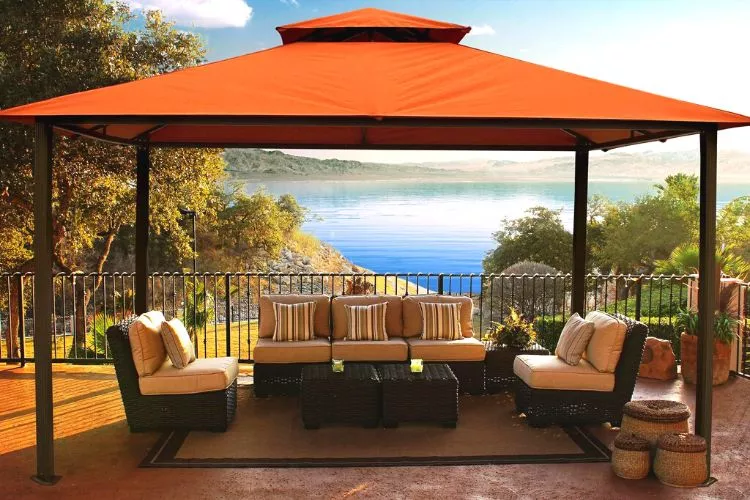
A soft top gazebo of the best quality and treated with care may last as long as 2 to 3 years. At the same time, a lesser quality fabric and battered and bruised frame may allow its user 6 or so months of quality usage.
Similar to hardtops, a soft top gazebos manufacturer will have a guarantee on their product. They will also recommend a maintenance routine to ensure the product’s longevity. If the maintenance isn’t done, the lifetime may become much shorter than the guarantee.
You May Also Find Useful: Gazebo vs Pavilion
Frequently Asked Questions (FAQs)
Can a hardtop gazebo stay up all year?
A hardtop gazebo can stay up for a whole year. It all depends on the type of materials that it is constructed with. Most hard tops are designed to withstand heavy winds, downpours of rain, snow, extreme heat, etc. Especially those built with a steel or aluminum frames cladded with heavier timbers or aluminum panels.
Are hard top gazebos loud in the rain?
Hard top gazebos aren’t designed to enhance the sound of the rain as they are generally pitched. The loudness of the rain is more attributed to the pitch of the roof. If a roof is flat, the rain will slam down on it, and the sound causes vibrations. A slightly pitched or angled roof will dampen the noise to the point where it may even be silent.
Can hardtop gazebos handle snow?
As long as the gazebo is constructed so that the snow can run off the roof, it can handle snow. Furthermore, the beams’ strength must also be able to take the weight. It’s important to have a good read through the manufacturer’s specs to help determine whether or not a specific gazebo will suit the conditions it may succumb to. High quality steel and aluminum are a must when setting up a gazebo to withstand snow.
Can a soft top gazebo withstand snow?
Soft top gazebos are generally made with fabric. Even if the fabric was of the highest quality, there is always the chance that heavy snow conditions could tear the fabric and damage the gazebo. Furthermore, the supports that come with most soft top variants aren’t usually designed to hold the weight of snow. Using them as a shelter where snow is present is not recommended.
Conclusion
As you read the hardtop vs soft top gazebo comparison, you now can understand, you should be purchasing a gazebo based on your usage. Hard top gazebos aren’t meant to be set up, dismantled, or thrown in the back of your car to go camping with. The same goes for soft tops. You wouldn’t set one up and expect it to withstand a snowstorm or even last ten years in your backyard as a garden pergola. We hope this article has helped trigger some thought, and we look forward to seeing you in the next one.

